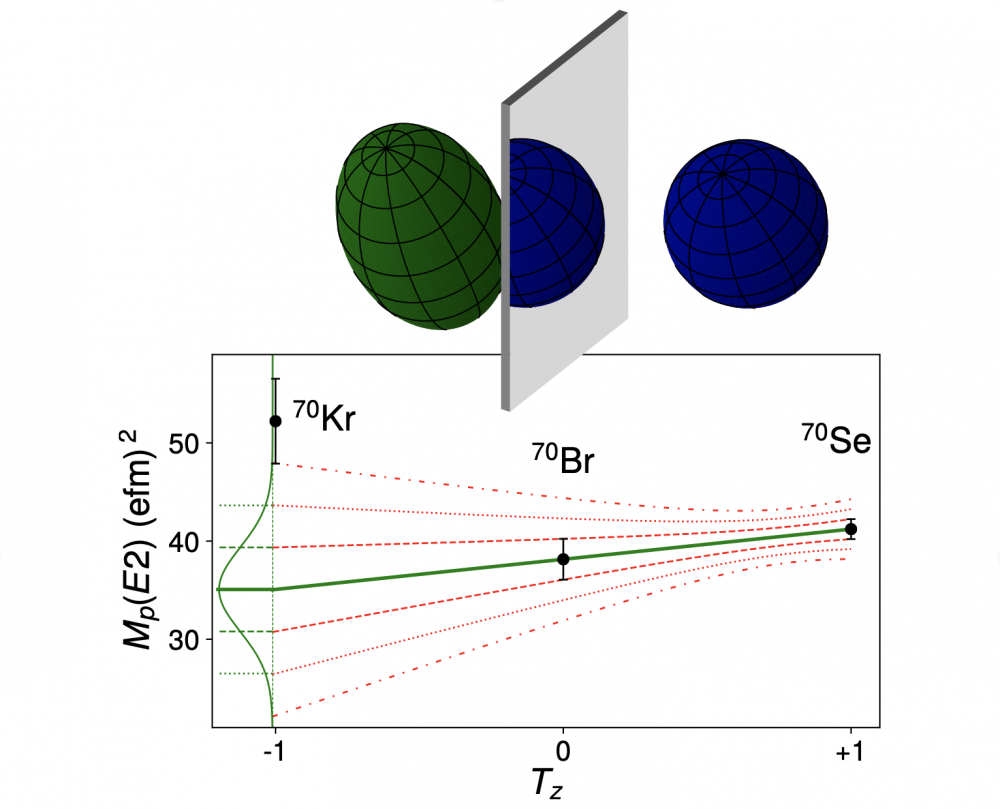Two “mirror” nuclei, in which the numbers of neutrons and protons are interchanged, have markedly different shapes—a finding that defies current nuclear theories. This striking result has been obtained by Irfu researchers in collaboration with an international team and has been recently published in Physics Review Letter [1] and highlighted as editor’s suggestion [2].
What is the isospin symmetry
The development of nuclear theories was aided by a postulated symmetry of the strong interaction holding nucleons together. This interaction, sees neutrons and protons as two (almost) degenerated states, called isospin states, of the same particle, the nucleon. Therefore one expects that nuclei with the same total amount of nucleons should present the same properties, for instance the same shape. However, this “isospin” symmetry isn’t exact. Indeed, contrary to the strong interaction, electromagnetism sees a major difference between proton and neutron: their electric charges, positive for the proton, and neutral for the neutron as its name suggests. Isospin symmetry breaking can be thus be spotted like for instance, in the slight mass difference between proton and neutron.

Figure 1: Schematic view of the Radioactive Ion Beam Factory (RIBF) at RIKEN. An intense high-energy krypton beam is created in a series of cyclotrons and impinges on the production target. Nuclei produced in a so-called fragmentation reaction are separated in the 1st stage and identified (tagged) in the 2nd stage of the BigRIPS spectrometer. At the end of the spectrometer the fragments impinge on a gold target, where they are electromagnetically excited. The spectrum of deexcitation gamma rays, detected with the DALI2 NaI(Tl) array, clearly shows the first excited 2+ state in 70Kr (see insert).
Mirror nuclei, the best probe to study isospin symmetry
Nuclei with the same number of nucleons, but with the number of protons and neutrons interchanged, are called mirror nuclei and are one of the best probes to study isospin symmetry. Due to the Coulomb repulsion nuclei with more protons than neutrons are very unstable and difficult to produce in the laboratory. Because of their extremely low production rates, mainly their first excited states could be studied in the past, but not their electromagnetic properties, such as the transition probabilities of excited states. The situation changed only recently with the advent of the second generation of Radioactive Ion Beam Factories (RIBF), such as the one at the RIKEN Nishina Center for Accelerator-Based Science in Japan, where these nuclei are produced with much higher intensity than before. These transition probabilities are directly related to the distribution of protons and neutrons inside the nuclei, offering a convenient way to confirm whether the isospin symmetry is a good mirror for nuclei, as expected from the theory.
Where and how can these mirror nuclei be studied?
At RIBF the team produced different nuclei with the same mass number of A=70: krypton (Z=36 protons and N=34 neutrons), bromine (35 and 35) and selenium (34 and 36). Stable krypton nuclei (A=78) were accelerated up to 70% of the speed of light and collided with a beryllium target. The fragmentation products created during this collision were sorted in-flight by a magnetic spectrometer and identified to form a secondary beam (see Figure 1). This beam containing a small fraction of the very exotic krypton 70 (T1/2 = 40 ms) was sent onto a gold target to induce electromagnetic excitation.
Hitting this gold foil, the nuclei produced quasi-instantaneously gamma rays at the frequencies of specific nuclear transitions. By measuring the gamma-ray intensity at these different frequencies using 186 NaI(Tl) scintillators, it was possible to extract the transition probabilities for the first time. These probabilities can be translated into the electromagnetic proton matrix elements shown in Figure 2. The slightly negative trend observed when going from selenium 70 to bromine 70, which is usually also observed in many lower mass nuclei, is clearly broken in krypton 70. The much larger value of the proton matrix element can be linked to a larger deformation as depicted above the graph.
The new results defy current theories
The experiments used a world-unique combination of instruments and technologies, essential for studying these heretofore inaccessible nuclei. They demonstrate an unexpectedly large isospin symmetry violation: transitions in the mirror nuclei krypton and selenium have probabilities that deviate significantly from theoretical predictions. These differences may reflect changes in nuclear shapes: selenium is probably slightly oblate—like a lentil—while krypton is much more deformed and probably prolate—like an rugby ball.
In order to shed light on an expected, although yet unobserved underlying trend with isospin, future studies will require even more “exotic” isotopes, where the imbalance of protons and neutrons is larger. Such exotic isotopes will be available, at the Super-Fragment Separator of the Facility for Antiproton and Ion Research (FAIR), currently under construction in Germany with CEA as shareholder and expected to be operational from 2025/26.
References
[1] "Shape Changes in the Mirror Nuclei 70Kr and 70Se", K. Wimmer, W. Korten et al., Physical Review Letters 126 (2021) 0725012
[2] Editor's Suggestion of Physical Review Letters and featured in Physics
Contact
• Structure of nuclear matter › Atomic nucleus Structure de la matière nucléaire




